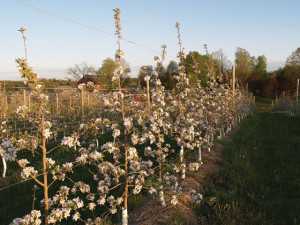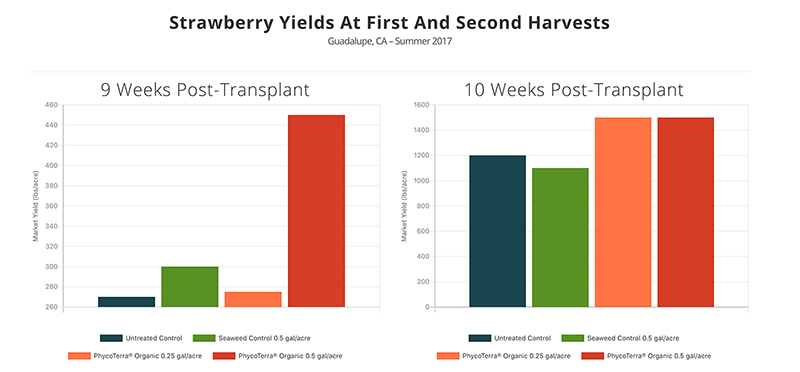Precision Cropload Management: Nibbling For Dollars

Full bloom is a good time for a first chemical thinning spray of this apple orchard, a Tall Spindle Zestar! block at Schwallier’s Country Basket in Sparta, MI. (Photo Credit: Phil Schwallier, Michigan State University)
Many researchers call it “Precision Cropload Management.” Phil Schwallier prefers the more descriptive term, “Nibble Thinning.” It means taking a number of little bites out of your apple crop until it’s just the right size to make you the most money.
“It means applying multiple thinning approaches,” says Schwallier, who as a Michigan State University District Horticultural Marketing Educator, must himself use research-speak from time to time. “It means gradually bringing down the initial crop load to our target crop load.”
The approach seems to make common sense. Also, it doesn’t cost much more than thinning just one or twice, and in fact it can save a lot on labor costs. (See “More Profits Now -— And Later.) But in colder growing regions a lot of growers think it’s just too risky. It’s hard to blame them, as growers in Michigan hardly produced a crop at all just two years ago.
“I think Michigan has perhaps the most adverse weather during spring than any of the major apple-growing areas of North America, which makes it difficult for us to be aggressive thinners — growers want to see the cropload before they start thinning,” he says. “The fear of the Michigan grower discourages early thinning, and we need to get over that.”
Here’s how to use “Precision Cropload Management,” says Schwallier.
Dormant Pruning — Some growers don’t consider this the first step, but Schwallier says it’s important to reduce the number of flower buds at this time to 1.5 times the target crop.
Full Bloom — This is the first chemical thinning. There are four basic materials. Schwallier says the first two, lime sulfur oil and ammonium thiosulfate (ATS), though commonly used in Washington, are too harsh for Michigan because they can damage the spur leaves that are important to set a nice big, quality apple. He prefers a plant growth regulator (PGR) such as NAA or MaxCel, especially the latter because it produces larger fruit.
Petal Fall — Here again Schwallier recommends a PGR, this time combined with Sevin. However, because Sevin can kill bees, he says growers need to make sure all the bees are out of the orchard prior to spraying.
“In Michigan, growers typically don’t thin at either of these times (full bloom and petal fall), which is unfortunate, because those are good thinning times and growers frequently let them go by,” he says. “They present an opportunity to do two chemical thinnings down to reduce the cropload to a level that could be near the target crop load.”
Fourth Nibble — At the 10 mm stage, another PGR application can be made with the help of two new tools, says Schwallier. These new tools are research models. The first model, developed by Duane Greene at the University of Massachusetts, predicts fruit set. The second is a carbohydrate model developed by Terence Robinson and Alan Lakso at Cornell University.
“Because of these models, growers can thin down fruit to the target level and achieve high-quality, large-size apples,” says Schwallier, “enabling them to capture those extra dollars.”
Fifth Nibble — Most growers will be done thinning by now, but if the fruitset models dictate it would be wise, then thin and fruit should be close to the 16-18 mm stage. An application of Sevin plus a PGR along with one gallon of oil per 100 gallons of water will give additional thinning of 10-15%.
There will be years hand-thinning may still be necessary, but for quality, not for size, says Schwallier. “I think if growers start thinning early, they can avoid hand-thinning,” he says. “Starting early, we think we can be very successful every year.”
More Profits Now — And Later
Growers who don’t nibble at their crop — thinning a little bit of it at several stages of growth — are often faced with too heavy a fruit set in early spring. If they want to command a decent price for their fruit, they have no recourse but to hand-thin the crop.
As any grower can tell you these days, that isn’t cheap. Labor is getting more scarce, and, consequently, more expensive. In the Grand Rapids, MI, area where Phil Schwallier advises growers, they typically pay anywhere from $500 to $800 an acre for hand-thinning.
But avoiding the cost isn’t the only reason to avoid hand-thinning, says Schwallier. Trees that set a larger crop reduce the crop for the following year more than those that receive early thinning.
“You won’t have as good a return bloom,” he says, “but if you nibble, you’re set to have a good crop year after year.”
A Must For Gala And Empire Growers
For those who grow apple varieties that tend to be small, such as Gala and Empire, it’s even more critical to throw caution to the wind when it comes to thinning early, says Schwallier.
Those growers who don’t thin at bloom and/or petal fall have very little chance of producing the big fruit for which the market pays big money.
“Think about it — it just makes sense,” he says. “Growers just have to have the courage to do it.”









